On this page
The State of Australia's Birds.The State of Australia's Birds is an annual series of reports that "collate and disseminate information on trends in bird populations to inform Australians of the status of their birds and help bring about improved understanding and better management of the land for birds and other biota. Electronic copies of the reports can be downloaded from the Birds Australia website.
For other books about Australian birds see the following page:
Australia bird books
|
|
|
|
The State of Australia's Birds 2010: Islands and BirdsCompiled by: Julie Kirkwood and James O'Connor
Birds Australia
2010
"This report features articles on a small number of Australia's precious islands, but it is only a snapshot of the situation, as more than 8,300 islands occur within Australia's jurisdiction. Indeed, only a small number of these islands are ever visited regularly by people who record biological data, and precious little is known about most of them. We are left to make inferences about what is happening on those unknown islands from what is happening on the few we have studied. Nevertheless, some distinct themes emerge from the articles in this report: a high level of endemism means islands represent a critical biodiversity ark; even small increments of climate change-induced sea-level rise will have grave consequences for low-lying islands; and invasive species have already caused widespread devastation of many islands' biological resources and ecological processes, and continue to do so at an alarming rate."
|
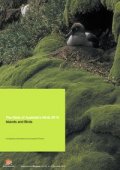 |
|
The State of Australia's Birds 2009: Restoring Woodland Habitats for BirdsCompiled by: David Paton and James O'Connor
Birds Australia
2010
"The 2009 report focuses on revegetation for woodland birds, particularly those in agricultual landscapes. Australia's woodlands - especially in the temperate south-eastern and south-western wheat and sheep belts - are among the most extensively cleared, fragmented and severely degraded habitats on the continent. And Australia's woodland birds, including many species generally regarded as common and widespread, are declining at an alarming rate. This publication concentrates on issues facing the revegetation of Australia's temperate and sutropical woodlands; particularly those that, historically, have overlapped with areas of intensive agriculture. There are a multitude of issues and a vast array of literature on this subject, and no attempt has been made at exhaustive coverage. The report merely introduces some of the key themes relevant to woodland birds - native vegetation clearance; revegetation; regrowth; spatial attributes; heterogeneity; and extinction debt."
|
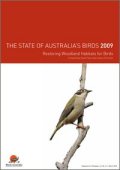 |
|
The State of Australia's Birds 2008: A Five Year ReviewCompiled by: Penny Olsen
Birds Australia
2008
"The 2008 report focuses on trends in bird populations as revealed by about 50 long-term monitoring programs running for up to 40 years. Thousands of volunteers, coordinated by a handful of individuals and groups, collected much of the data. This is an extraordinary expression of concern for Australia's birds and their habitats. Without such long-term commitment, how are we to understand which bird species and communities are truly in trouble, where to focus conservation efforts, what environmental management works and whether our management of the land is sustainable? Although the report deals with birds, the findings have much broader implications for nature and society - birds are indicators of national quality of life. The latest results show that populations of many common bird species are in decline, evidence that the natural environment is continuing to be eroded through over-use, underinvestment in its care and restoration, and undervaluing of its importance."
|
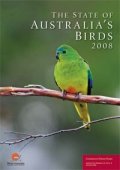 |
|
The State of Australia's Birds 2007: Birds In A Changing ClimateCompiled by: Penny Olsen
Birds Australia
2007
"Climate change is bringing mixed news for Australia's birds. Some species will benefit, others will be disadvantaged over and above the other long-standing threats they face. We don't know how quickly birds can adapt to the changes, but we think that many will and we know that some won't. To facilitate adaptation, connectivity is the catch-cry: reconnecting natural landscapes and habitats and connecting biodiversity to carbon policies and procedures."
|
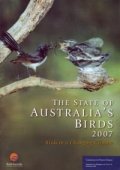 |
|
The State of Australia's Birds 2006: Invasive SpeciesCompiled by: Penny Olsen, Andrew Silcocks and Michael Weston
Birds Australia
2006
"Australia has hundreds of invasive plants and animals, both native and introduced. Some were brought purposely, others hitchhiked; the majority have taken the many opportunities offered by human alteration of the landscape. Invasive species are considered to be the greatest threat to biodiversity after habitat loss; they also exact a massive toll on agricultural production. This fourth report in the SOAB series presents examples of just a few of the issues and opinions concerning invasive species in Australia, particularly as they relate to birds. The problems are complex and the management options limited. Invasive species are widely regarded as second only to habitat loss as the greatest threat to birds. Yet, only rarely is the real impact of invasive species known. Further, the effectiveness of control actions against invasives is seldom measured in terms of the reduction in the environmental or economic damage caused."
|
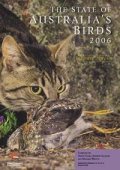 |
|
The State of Australia's Birds 2005: Woodlands and BirdsCompiled by: Penny Olsen, Michael Weston, Chris Tzaros and Andrew Silcocks
Birds Australia
2005
"This third annual report focuses on woodland birds. Woodlands once covered one-third of the continent. The 'great Australian bush', with its kookaburras and magpies, is part of our national identity. Yet, in the south much of the bush has given way to agriculture. In the north, the trees may remain but savannas are degraded by livestock grazing, the effect of which is exacerbated by invasive grasses in combination with inappropriate fire regimes. It should come as no surprise that woodland plant and animal communities are the most threatened in the nation. Clearing reforms are welcome and restoration is underway, but temperate woodland remnants continue to erode and bird species losses seem probable in coming years. Across the northern woodlands, seed-eaters will continue to decline unless grazing, invasive pasture grasses and fire are better managed. In the agricultural lands the situation is critical, with cessation of incremental clearing, lessening of grazing pressure and restoration of woodlands priorities for action. This includes the return of structural and spatial diversity: trees, shrubs, litter, ground cover and other elements in a patchy mosaic."
|
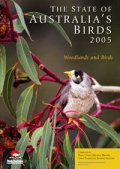 |
|
The State of Australia's Birds 2004: Water, Wetlands and birdsCompiled by: Penny Olsen and Michael Weston
Birds Australia
2004
"This report examines the status of birds associated with Australia's wetlands at both national and regional scales. It highlights the main threats they face, the species in need of attention, and the national and international efforts to protect them. The performance of governments is examined by their response to the identification of species of high conservation concern in the Action Plan for Australian Birds 2000."
|
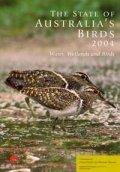 |
|
The State of Australia's Birds 2003Compiled by: Penny Olsen, Michael Weston, Ross Cunningham and Andrew Silcocks
Birds Australia
2003
"SOAB 2003 is the first in a series of reports summarising the fortunes of Australia's birds. It presents population trends and changes for Australian birds over various time spans - some extending from the 1960s - leading up to the present. It is intended that this introductory SOAB report sets the baseline for five-yearly overviews, informed by the Ongoing Atlas of Australian Birds and many other monitoring programs. These overviews will be interspersed with themed reports on topics such as habitat change, freshwater birds, seabirds, shorebirds, and the fate of birds on islands."
|
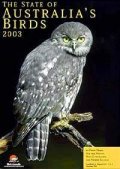 |
|